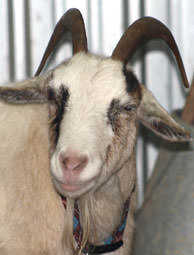
 Photo by Sue Weaver Sweetie, the Pygmy goat, is still in quarantine on our farm while recovering from pinkeye. |
This is Sweetie. She’s a Pygmy goat. One of Mom’s friends rescued Sweetie, but now Sweetie needs a home so she’s come to live with us on our farm.
Some people Mom’s friend knows bought Sweetie at a sheep and goat auction at a place called a sale barn. People bring their animals to sale barns to sell them fast, but they’re not good places to buy. Animals sold at sale barns are often sick or there’s something wrong with them. It’s better to buy livestock from individuals or breeders. Here’s why:
Even if an animal isn’t sick before it’s sold through a sale barn, it’s exposed to disease on sale day. Some serious diseases you can bring home are strangles and flu in horses; hoof rot in cloven-hoofed animals; an incurable abscess-causing disease called caseous lymphadenitis in sheep and goats; and respiratory disease in livestock of all kinds.
In addition to sick animals, some people take other kinds of problem animals to sale barns to sell to unsuspecting buyers. They’ll sell sows that never get pregnant, rams that knock people down, a tiny goat accidentally bred to a huge studly buck like me, and animals with fatal wasting diseases, like Johne’s disease (in cattle, sheep and goats), caprine arthritis encephalitis (in goats) and ovine progressive pneumonia (in sheep).
Mom won’t go to sale-barn auctions because she feels sorry for so many animals and wants to bring them home. She’s afraid she’ll be tempted to buy some. If you go to—and especially if you buy at—sale barns there are things you really should know.
As soon as you get home from the sale barn, go straight inside and wash your hands, then change your clothes and don’t wear them again until they’ve been laundered. Spritz your shoes and boots with a solution of one part chlorine bleach to 10 parts water, and allow them to dry before wearing them again. Never go directly from the sale barn to your animals’ living area. You can carry disease pathogens on your clothes and shoes.
If you buy an animal at a sale barn, put it in quarantine. It should have a comfortable area of its own where it can see other animals but they can’t come too near; 50 feet from the rest of your animals is good. Keep the animal in quarantine for at least three weeks—four is better. Use separate feed and water containers and grooming supplies for the animal in quarantine. Feed and care for your other animals first and the quarantined one last, so you don’t carry disease from the quarantine area to the rest of your farm.
These biosecurity measures sound extreme, but they makes good sense. Sweetie had a squinty eye caused by pinkeye and a deep cough when she went through the auction. If the nice people who rescued her hadn’t quarantined her when they took her home, the rest of their goats might have gotten pinkeye, too!




